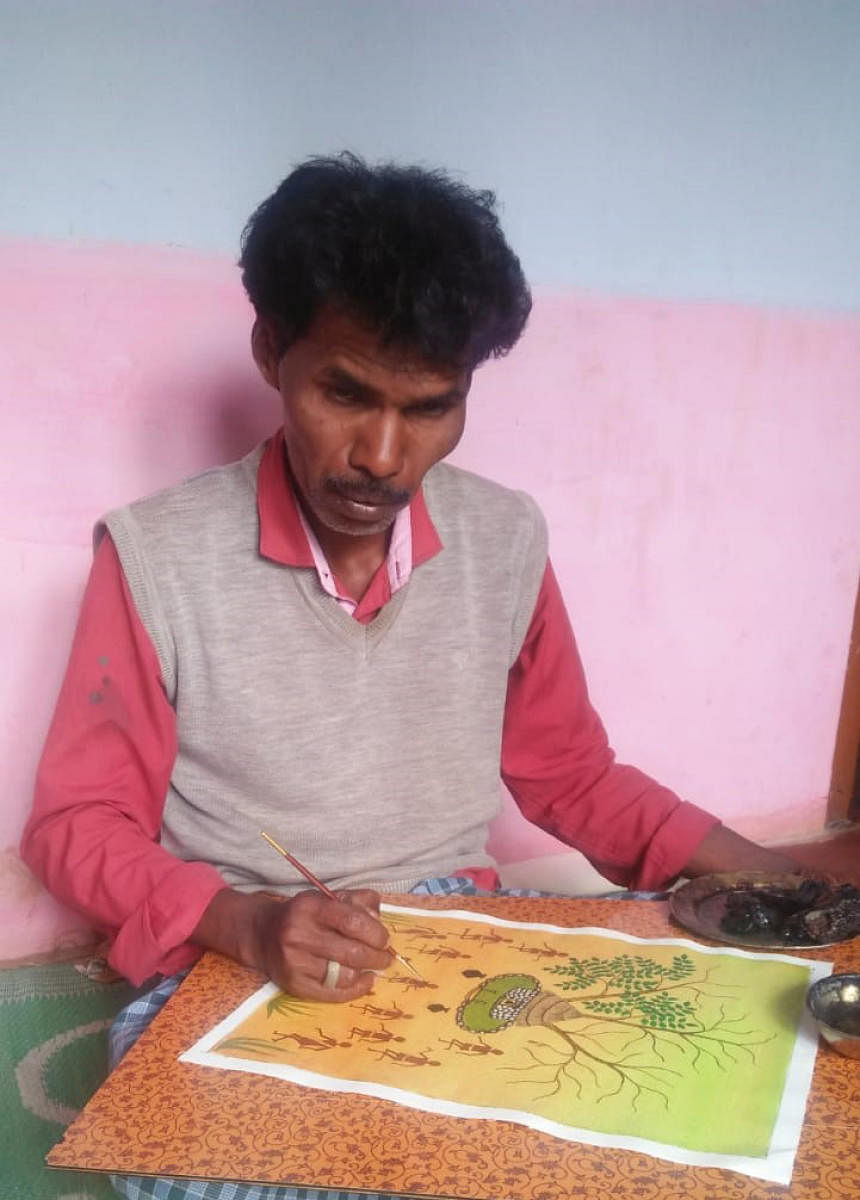
Efforts are on in Karnataka to popularise the Kurumba art form, a 3,000-year-old traditional painting technique that has its origin in the Nilgiri ranges of Tamil Nadu.
Until about two months ago, very little was known about the Kurumba art in Karnataka. Then, the Sree Kalaniketana School of Art, Mysuru, took up the initiative to study this ancient art form. Mahadev Shetty, the principal of the school, deputed two staffers, Ravish and Vithal Reddy to participate in a national-level art camp at Thanjavur in Tamil Nadu.
“We were thrilled to see the Kurumba creations. We collected more details about the art from Krishnan who was conducting the training,” Reddy explains.
After the duo returned to Mysuru, they trained a group of students. “This ancient tribal art is on the brink of extinction. There is a dire need to pass on knowledge to younger generations in the state,” says Ravish.
Who are Kurumbas?
One of the five communities which occupy various altitudinal zones of the Nilgiri ranges, the Kurumbas are believed to be the descendants of the Pallavas. These forest dwellers are known for their healing powers, skills in hunting and herbal medicine.
Krishnan is believed to be the only surviving Kurumba art specialist from his community. According to Krishnan, the Kurumbas’ ancestors were responsible for the glorious 3,000-year-old rock art at Ezhuthupaarai, an archaeological site in the Kothagiri region of the Nilgiris.
The Kurumba paintings depict the tribe’s way of life--farming, animals, their honey hunting escapades etc.
The themes include harvest festivals, religious rituals, social gatherings, huts built of leaves and wood, women drying food grains, earthen pens for hens and wild animals prowling the forest.
In subject, the Kurumba art is quite similar to Warli painting and Saura folk, but different in style. This simple rectangular art distinctly differentiates male from female. While lines are used for figures, the style is minimal. The lines are independent and concentric.
“The Kurumba painting is slightly different from the Warli painting. While the Warli painting uses one colour, the Kurumba uses more than three colours. It is slightly difficult in technique,” C S Krishna Setty, the former chairman and administrator of Central Lalitha Kala Akademi, New Delhi and former chairman of Karnataka Lalithakala Academy says, adding that there is a need to popularise it.
Natural colours obtained from the leaves and tree resins are used for the illustrations of the Kurumba art form. Traditionally, artists use the colours red, mustard, black and green. These are obtained from the bark of trees or from the leaves of plants. The tree resin and leaves are mixed with red and white mud varieties. A piece of cloth is used to apply colours onto walls built using cow dung.
In the past, rock surfaces, the outer walls temples and houses were used as the canvas for painting. Today, the artists use watercolour on handmade paper.
Brink of extinction
Krishnan hails from Velaricombai, a Kurumba settlement, which is just a few kilometres away from his hut. He learnt the art from the late Mathan, his grandfather, at the age of six. Mathan had earned local fame by decorating the walls of the tribal temples located across the district.
It was the C P Ramaswami Aiyar Foundation that introduced the art to the outside world. However, there was no financial assistance to Krishnan to carry forward the legacy.
He adds, “Only a handful of the Kurumba families are now left in the forests. Many of them have scattered all over South India over the years. Most of the youngsters have relocated to urban areas for livelihood as they feel they can’t make a living out of this art.”
Krishnan is also an expert in herbal medicine preparation. He draws paintings during festival seasons.
Now, about 60 students of Kalanikethana and five others have mastered the intricacies of the art and are ready to exhibit their creations, finding new fascination with the old form. “I had not heard of Kurumba art. I was attracted to its beauty. Though I faced some initial challenges, I learnt it,” Swathi Madanna, one of the students from Mysuru, says.
The school had also planned an exhibition and training programmes in Bengaluru and other cities of the State. However, the plan was put on hold due to Covid-19 pandemic induced lockdown.
(The Tribal Cooperative Marketing Development Federation of India (TRIFED) conducts workshops for Kurumba tribes. Tribal Research Centre campus Udhagamndalam, Nilgiri district, exhibits the Kurumba paintings)